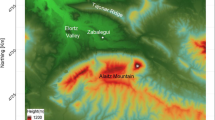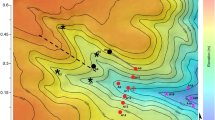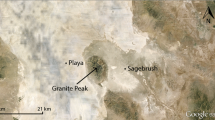Abstract
During nocturnal cooling over land, the 10-m wind speed falls to very low values in many parts of the world while the absolute sensible heat flux increases initially after sunset but reaches a maximum before decreasing later in the night. In contrast, a one-dimensional numerical model predicts that the nocturnal wind speed is constant after an initial reduction at the evening transition. The difference between observations and the model is attributed to topographic effects which can be significant even over minor orography. Using data from exceptionally flat sites, we show that, in the absence of topography, the nocturnal wind speed is constant and the sensible heat flux tends towards a limiting value during prolonged surface cooling.






Similar content being viewed by others
Notes
Cooperative Atmospheric Surface Exchange Study October 1999.
References
Blackadar AK (1957) Boundary-layer wind maxima and their significance for the growth of nocturnal inversions. Bull Amer Meteorol Soc 38:283–290
Derbyshire SH (1990) Nieuwstadt’s boundary layer revisited. Q J R Meteorol Soc 116:127–158
Kaimal JC, Wyngaard JC (1990) The Kansas and Minnesota experiments. Boundary-Layer Meteorol 50:31–47
King JC, Connolley WM, Derbyshire SH (2001) Sensitivity of modelled Antarctic climate to surface and boundary-layer flux parametrizations. Q J R Meteorol Soc 127:1779–1794
Lapworth AJ, Claxton BM, McGregor JR (2015) The effect of gravity-wave drag on near-surface winds and wind profiles in the nocturnal boundary layer over land. Boundary-Layer Meteorol 156:325–335
Nieuwstadt FTM (1985) A model for the stationary, stable boundary layer. In: JCR Hunt (ed) Proceedings of IMA conference on turbulence and diffusion in stable environments, Cambridge 1983 (OUP), pp 149–179
Parish TR, Oolman LD (2010) On the role of sloping terrain in the forcing of the Great Plains low-level jet. J Atmos Sci 67:2690–2699
Poulos GS et al (2002) CASES-99: a comprehensive investigation of the stable nocturnal boundary layer. Bull Amer Meteorol Soc 83:555–581
Acknowledgements
We would particularly like to thank Larry D. Oolman for his help in providing long-term meteorological data from the University of Wyoming weather archive. Data from the Anthony and Coldwater sites were obtained from the ARM User Facility, a U.S. Department of Energy Office of Science user facility managed by the Office of Biological and Environmental Research. Data from U.K. sites were provided by the U.K. Met.Office.
Author information
Authors and Affiliations
Corresponding author
Additional information
Publisher's Note
Springer Nature remains neutral with regard to jurisdictional claims in published maps and institutional affiliations.
Rights and permissions
About this article
Cite this article
Lapworth, A., Osborne, S.R. The Nocturnal Wind Speed and Sensible Heat Flux Over Flat Terrain. Boundary-Layer Meteorol 176, 401–413 (2020). https://doi.org/10.1007/s10546-020-00534-9
Received:
Accepted:
Published:
Issue Date:
DOI: https://doi.org/10.1007/s10546-020-00534-9




